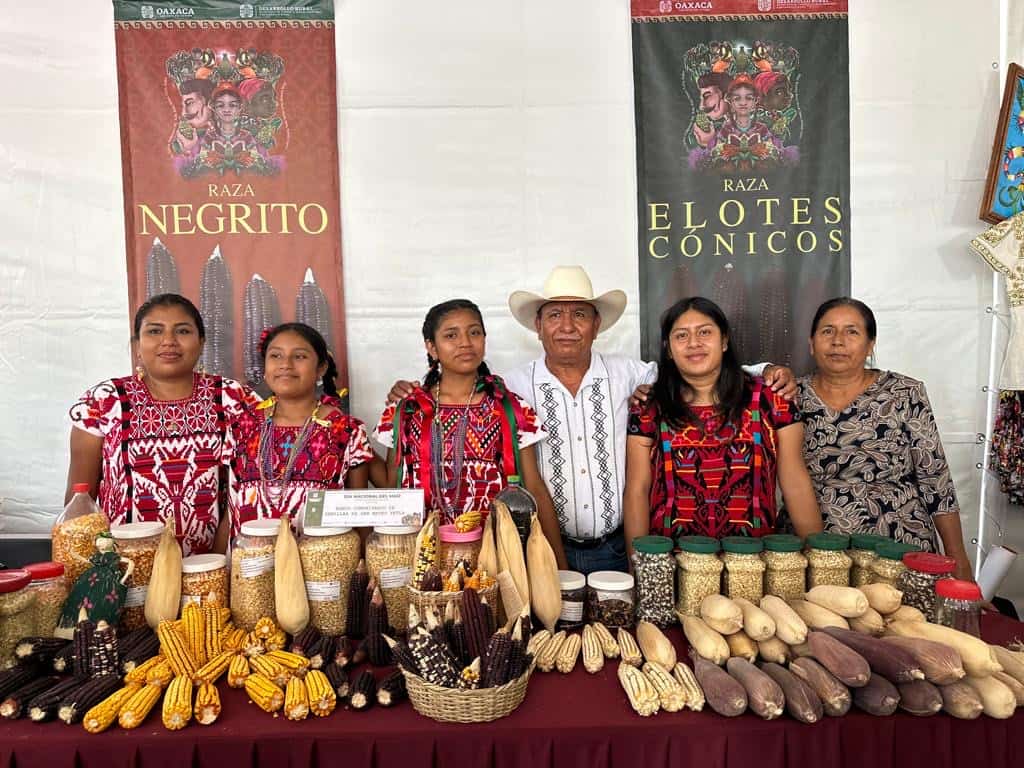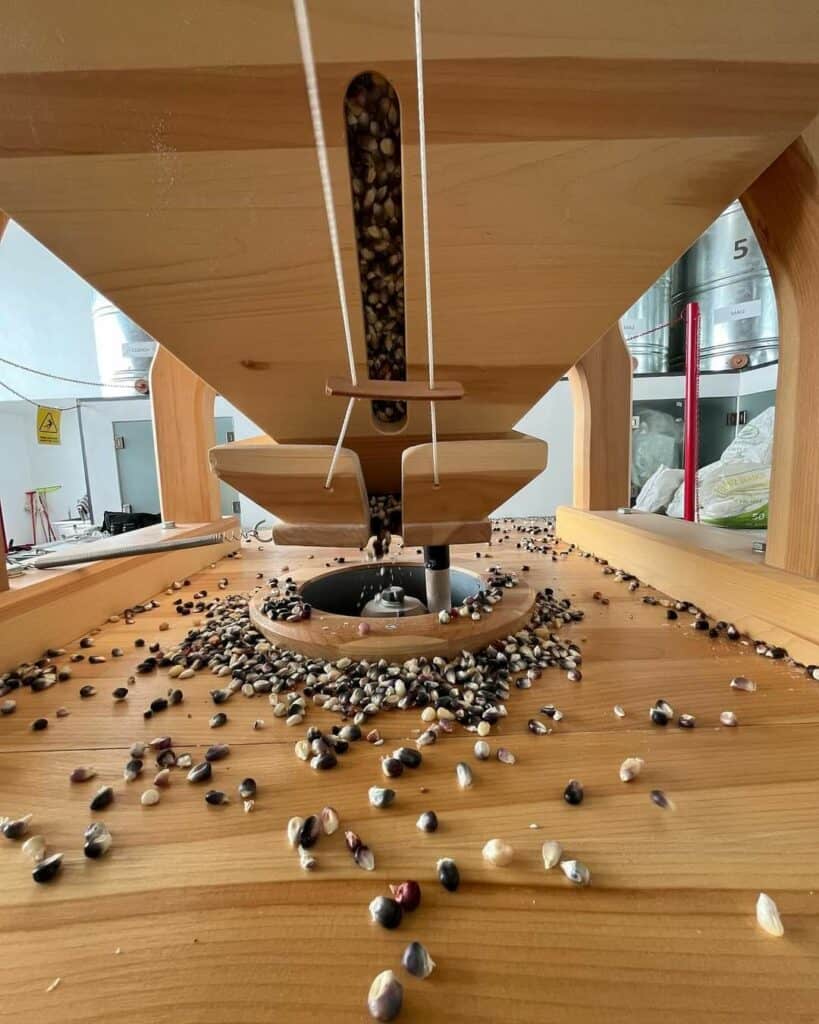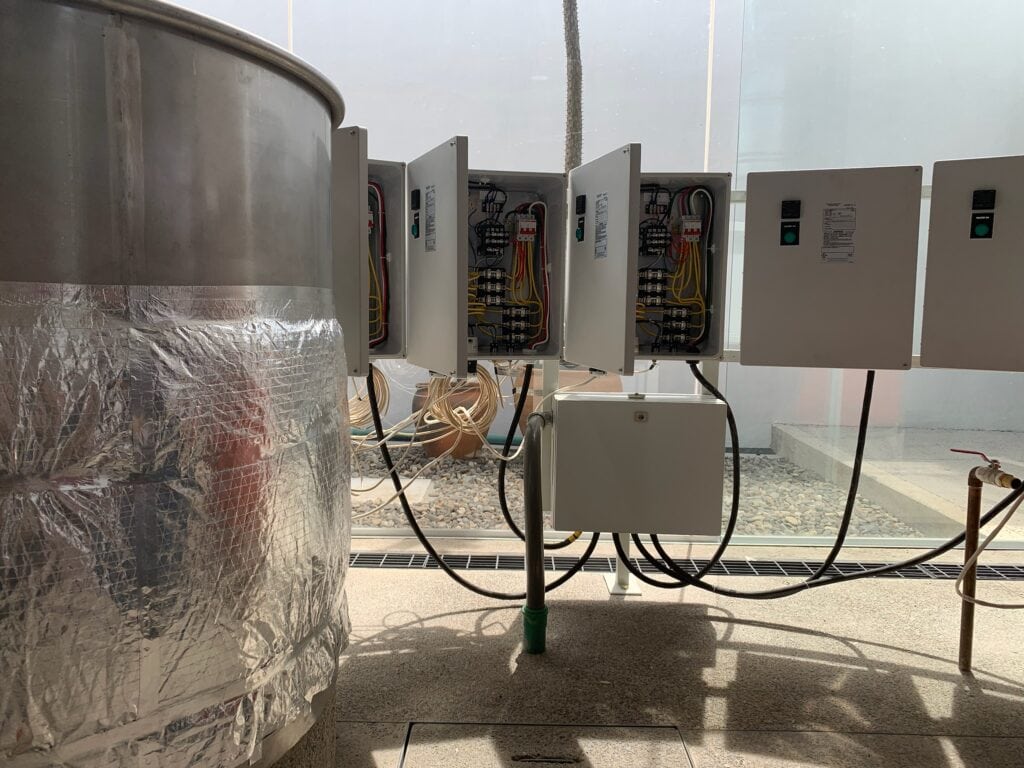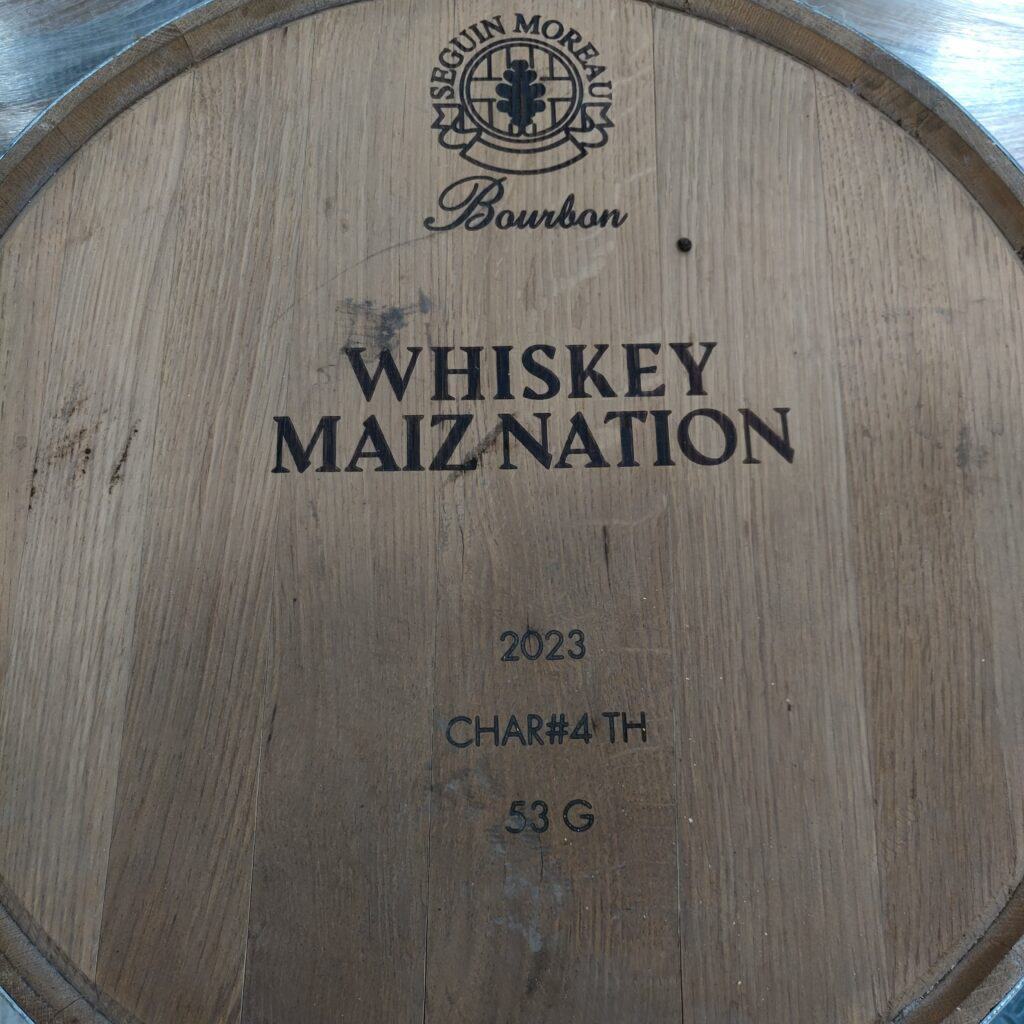The case of Mexican corn whiskey
“When our corn leaves the civilization that gave it origin, the subject and the object split; corn loses its ‘humanity’ and transforms into an object: a traveling plant that produces grain and seed. But in Mesoamerica, ‘the cyclical vision of the grain that is buried as a seed to give life remained alive,as the foundational thread upon which the Mesoamerican civilization was woven for thousands of years. In the indigenous and peasant communities of Mexico, corn never lost its humanity’ (Solares, 2007).”
In today’s era of environmental consciousness, there’s a widespread movement toward redefining our lifestyles to minimize our ecological footprint. This includes a reconsideration of everything from our clothing choices to our dietary habits and social interactions, even extending to our beverage preferences. Within this paradigm shift, there’s a growing interest in revisiting the ancestral wisdom of indigenous communities, who historically lived in harmony with nature, shunning the excesses of modern consumerism. This renewed focus has propelled native corn into the limelight, with its profound symbolic significance deeply ingrained in the cultural fabric of corn-consuming communities, particularly those deeply intertwined with its cultivation. However, the discourse surrounding corn is laden with multifaceted implications, spanning the realms of politics, economics, society, and emotions, emblematic of both our rootedness to the land and our detachment in urban landscapes where corn serves primarily industrial purposes.
The resurgence of heirloom corn and other indigenous seeds emerges as a repository of ancestral wisdom, offering invaluable insights to navigate contemporary challenges such as biodiversity loss, climate change, and food insecurity. The popularity of Mexican heirloom corn, gaining traction over the past decade, reflects a global trend, initially observed in the United States and subsequently mirrored in Mexico. While in the US, the importation of Mexican heirloom corn is driven by its nutritional value amidst a landscape dominated by genetically modified corn, Mexico grapples with the paradox of importing American corn for its accessibility despite being a major corn producer itself.


In 2015, I toyed with the idea of launching a tortilleria in Washington DC but a friend advised me to pivot towards street food due to the limited market for a tortillería in the capital city at the time. I not only took his advice but also made him my business partner, marking the beginning of my entrepreneurial journey after nearly eight years of working for the Mexican government in DC. To ensure authenticity, I sought out providers of heirloom corn directly bypassing intermediaries. A trip to Michoacán in December 2015 allowed me to sample corn during harvest time,and to immerse myself in a self-taught nixtamalization journey and evoking memories of family recipes. Despite initial challenges, including mishaps with equipment and imports, I persevered and eventually collaborated with Tamoa, a Mexican distribution company, to streamline operations and ensure fair trade practices. Despite our growing sales, the looming expiration of my work visa led me to return to CDMX in 2019, where I continued to explore the cultural significance of corn.
Through this experience, I realized my disconnect from corn’s roots and rural livelihood in Mexico, despite growing up eating corn-based foods. It wasn’t until I visited farmers in Michoacán and delved into the world of nixtamalization that I truly grasped the importance of corn in Mexican culture. Returning to CDMX, I contemplated starting a similar business but questioned how I could compete with local vendors deeply entrenched in the community’s culinary fabric.
Why is native corn not consumed on a mass level?
The implementation of the North American Free Trade Agreement (NAFTA) in 1994, followed by the United States-Mexico-Canada Agreement (USMCA or TMEC), transformed Mexico’s agricultural landscape by eliminating tariffs on basic imports and encouraging a form of agri-food domination driven by the United States. This led to Mexico, for the first time, becoming a net importer of basic grains like corn, wheat, rice, and soybeans. Additionally, the policies imposed as a result of these agreements promoted the consumption of highly processed products containing preservatives and high sodium levels. Consequently, traditional dietary practices in rural communities, which relied on backyard agriculture or subsistence farming, have been affected by the influx of ultra-processed foods.
Until the introduction of hybrid seed produced by national breeding programs, influenced by the technological trajectory of industrial agriculture that was consolidated in the United States in the 1960s, native corn has been marginalized. Under this scheme, highly productive and uniform hybrid varieties were developed to meet the needs of large-scale monoculture production on the best lands. Yields increased through intensive investment in fossil energy and external inputs, prompting public and private interest in plant genetic research. (Kato A., 2013)
According to the Agroalimentary Information Consultation System (SIACON), in 2022, Mexico produced 26.5 million tons of maize, with 13.7 million tons being native varieties. Since there are no recorded figures regarding the export quantities of such, we rely on information from companies like Masienda, a major masa purveyor in the US, which reported importing 1,270 tons of corn in 2023 from seven different states in Mexico. If we compare these numbers, not much of the native corn produced is being sent abroad. However, just recently the Mexican government reported a record figure of corn imports from the United States, reaching 18.2 million tons in 2023. This juxtaposition reveals a dilemma for native corn producers in Mexico, torn between local consumption and lucrative international markets.
Traditional agriculture plays a crucial role from economic to social and cultural perspectives. The small agricultural production units, ranging from 5 to 20 hectares, serve as a cornerstone in feeding the nation. About sixty per cent of the national corn production comes from these units which are mostly rainfed.(Suárez, 2021)
| Mexico total maize production data | |||
| Area planted (Million ha) | Production (Million t) | Yield (ton/ha) | |
| 2011 | 7.75 | 17.64 | 2.9 |
| 2012 | 7.37 | 22.07 | 3.2 |
| 2013 | 7.49 | 22.66 | 3.2 |
| 2014 | 7.43 | 23.27 | 3.3 |
| 2015 | 7.43 | 23.27 | 3.3 |
| 2016 | 7.76 | 28.25 | 3.7 |
| 2017 | 7.54 | 27.76 | 3.8 |
| 2018 | 7.37 | 27.17 | 3.8 |
| 2019 | 7.16 | 27.23 | 4.1 |
| 2020 | 7.47 | 27.42 | 3.8 |
| 2021 | 7.31 | 27.50 | 3.9 |
| 2022 | 6.90 | 26.55 | 3.9 |
Into this landscape, the emergence of Mexican corn whiskey
Over the past several years, there has been an emergence of Mexican corn whiskies that focus on using heirloom native corn in the production. It has raised questions of whether this is the best use of native corn – is this just further extraction of a culturally rich product that has become a precious export or is this a new market for farmers working to preserve heirloom varieties? Maiz Nation, a Mexican corn whiskey made with native corn, aims to be the latter. It presents an interesting model on how businesses can operate responsibly with farmers and the environment by supporting traditional farmers so they can keep farming their land and making a living out of it.
Jonathan Barbieri and Yira Vallejo, the couple behind Pierde Almas mezcal, have been making whiskey since 2014, initially as a side project while they remained focused on their mezcal brand (note, they sold the mezcal brand to Diageo in 2018). They started in a distillery in San Andrés Huayapam, Oaxaca using corn they purchased from Floriano Garcia Delfin, a farmer from the Chinantla region, bordering Veracruz. They met García during the State Agrobiodiversity fair, an annual event that aims to preserve the genetic richness, uses, and culinary quality in the production of traditional products from the eight regions of Oaxaca, as well as to promote the exchange and improvement of native seeds among farmers. Vallejo and Barbieri had sponsored it in the past and in 2017, Yira became one of the organizers.


For Barbieri, it doesn’t matter if they are using blue, red or white corn for a new batch of whiskey since the corn color will not affect the result as it does with tortilla/masa making. The important part for them is that the flavor of the corn comes from the care and knowledge of the farmers who for generations have been breeding these landraces (local cultivars). Beyond terroir, their maize based spirits are a reflection of how the farmers have been adapting to nature.
Barbieri and Vallejo began with a 375ml presentation of the whiskey and sold it in a few cities in the US where it was greatly received among fellow Mexicans living in the United States. In 2022, they began designing a new and bigger distillery and moved to San Agustin Etla, Oaxaca.
Meet the SolCroft distillery

Both Vallejo and Barbieri wanted to create a distillery that was 100% sustainable. Construction began last October (2023) and opened early this year (2024). I had an opportunity to visit the distillery, called SolCraft, just after it opened. The distillery represents the greatest business investment they have ever made. The design is well thought out to maximize the space and be power efficient. One notable detail is the terrain’s downward slopes, facilitating the easy unloading of raw materials, such as corn, upon arrival at the property, streamlining the initial stages of the production process.
This sloping allows for an easier transportation of the residual water from the distillation process out into a system to treat the viñazas, which they define as “ a natural rhizome-filtration treatment plant to return water with neutral pH to the local ecosystem”. It is part of an ancestral filtration system that uses endemic plants and algae in a biological process to clean the water. Their goal is for more projects to replicate this technology within the community.
The full distillation process is powered entirely by the energy captured through 102 solar panels and 12 batteries makes them self sufficient, with no dependency on the main provider of power which is a federal agency. They can generate 56,000 kilowatts per hour.


Native corn—brought in by families in farming communities with whom (they) have been working for ten years—is milled in a baker’s mill built in Tyrol, Austria, equipped with a 10hp motor and a 400 kilo (880lbs) millstone. The mashing process starts with water being poured into the 900-liter mash tuns and heated by solar power. Then, the just-milled corn flour and malted barley are added; the latter for the natural enzymes it provides. The tanks are jacketed in electric heaters that run on 100% solar energy. They can very quickly reach temperatures of up to 320 degrees Celsius and must, therefore, be carefully monitored.




The mash is boiled for forty minutes and then cooled for inoculation with sour mash saved from the previous day. This delicate process is repeated twice a week from 8:00 am to 4:00 pm. They will fill four fermentation tanks, each with a capacity of 440 liters, ensuring a steady supply for the distillation process. In each tank about 550 liters of “atole” is cooked in 100% roof-harvested rainwater. An additional 200 liters of rainwater is added for cooling once the heaters are turned off. This results in about 900 liters of mash, including the approximately 200 kilos of milled grain.
This meticulous attention to detail extends to their fermentation tanks, of which they have a total of twelve working in any given week. Each mash tank, once completely prepared, results in two, stainless steel fermentation tanks/vats. Fermentation begins at around 35 degrees Celsius, then climbs to 38° as the yeast multiply and devour the hydrated sugars in the mash, before descending over six days to ambient temperature. Temperature, pH, brix, biological activity, smell and taste are carefully recorded, then graphed for comparison in a constant search for optimum flavor profiles before the first distillation takes place.
The añejo expression, bottled at 47 ABV, is aged in American oak barrels for two years, enhancing its depth and complexity. Despite various climatic challenges such as hot days and cold nights, the facility’s location at 1650 meters above sea level actually provides optimal conditions for maturation. Barbieri explained to me that unlike bourbon, which takes five years to develop its distinctive flavor, and Scotch whiskey, which requires no less than twelve years, “Mexican corn whiskey embodies the flavors that have been developing since the corn was planted, offering a truly unique sensory experience”. Each batch of whiskey produced yields 250 bottles of 700 ml of white whiskey which is rested for 3 to 4 weeks and bottled at 48 abv. They also make Rye whiskey using local rye and have created a special blend edition with Barbieri’s recipe which combines 65% corn, 20% wheat and 15% rye, aging it for two years and bottling at 50.4% ABV.





The facility’s commitment to sustainability extends to its rainwater storage capacity, which stands at an impressive 25,000 liters, ensuring minimal environmental impact throughout the production process. To celebrate their 10th anniversary they will release the first batch of whisky made entirely with rainwater.
The guardian of corn
Floriano García is from the community of San Mateo Yetla in the municipality of Valle Nacional, Oaxaca. This is in the Chinantla region close to Veracruz. He has been a traditional farmer all his life and learned from his father how to work the land. In each territory of indigenous peoples and in rural communities, we find landraces of corn and different varieties adapted to specific ecological conditions. This morphological differentiation among different corn landraces is considered to be related to ecological variation (Hernández X., 1987) and the culture of indigenous peoples.
Garcia learned of a rare maize landrace known as Papaloapan, which was lost in the region in part due to the increased use of hybrid varieties and its tall stature that made it unsuitable for the windy conditions of the area, leading to its decline in cultivation. The genetic material of native corn is utilized both for preservation in seed banks and for producing hybrid seeds which started proliferating in Garcías community around 1985. However, he advocates for the preservation of native corn not only in seed banks but also by actively planting them. This is why he visits the State Agrobiodiversity Fair in Oaxaca city every year, so he can obtain seeds of lost varieties such as the Papaloapan to experiment in his land and help preserve the different landraces. Once a fellow farmer agreed to sell him a corncob of this variety, he took it home and planted the seeds. Since then, he has been meticulously monitoring its growth to prevent cross-pollination. He grows other landraces such as olotillo and bolita; he follows a careful planting schedule, staggering the sowing times during the fall-winter season to preserve the diversity of each variety. In November, he plants 5 to 6 kilograms of a specific variety, allowing a one-week gap between plantings to facilitate wind-assisted pollination.
With 45 years of experience in agriculture, Garcia’s dedication is evident. He owns prime land purchased from his brother-in-law, who served as executor of his in-laws’ estate. Unlike his siblings, who pursued professional careers or moved to the United States, Garcia chose to continue the family tradition of farming. He expresses his disdain for the work-driven lifestyle he experienced while living in Los Angeles. In addition to farming, he manages a pasture and serves as a member of the communal property committee for his town. García prioritizes environmental conservation and biodiversity preservation in his community. “Farmers adapt, we are creative” he continuously asserts when referring to how climate change has altered the production calendar. In his region, they have set aside 850 hectares of mesophilic forests for protection, relying solely on organic agricultural practices and refraining from using glyphosate.

He plants canavalia beans to enrich the soil and strictly prohibits the use of single plastic and foam items in his community. Garcia plays a vital role in his community, leading a group of 72 organized farmers and overseeing a seed bank. They are currently seeking funding for solar panels to enhance the seed bank’s facilities. Despite facing extreme weather conditions, such as heavy rainfall and droughts, Garcia and his fellow farmers adapt to the challenges of climate change. He observes changes in weather patterns, adjusting his planting schedule accordingly to optimize crop yields. His commitment to preserving traditional maize varieties and sustainable agricultural practices reflects his deep connection to the land and his community.
Garcia’s friendship with Barbieri and Vallejo spans over ten years. Together, they explore various maize varieties, distinguishing them by color, texture, and taste. Garcia contributes to the preservation of these diverse maize varieties, ensuring that future generations can continue to enjoy their rich cultural heritage.
For Maíz Nation, other varieties are used like Chalqueño corn from the Mixteca region and Olotillo corn from the coast, as well as Bolita and Tepecintle varieties. They only buy the surplus that each producer agrees to sell depending on the harvest. For example, because of last year’s minimal rain and the resulting drought during the spring-summer cycle, García was only able to obtain 800 kilograms to sell after 500 kilograms for their own consumption were set aside.
About appropriation
In addressing the issue of cultural appropriation Barbieri, an American who relocated to Oaxaca four decades ago, offers a unique perspective shaped by his deep integration into Oaxacan society. For Barbieri, immigration transcends mere survival needs; it carries a spiritual significance, as one emotionally invests in their chosen destination. Upon his arrival, Barbieri didn’t assert dominance but rather sought assimilation into the culture, recognizing the impact of his actions on the local community. Despite arriving with limited resources as an artist, Barbieri emphasizes the importance of generosity and involvement, citing Oaxaca’s kindness in return.
He underscores the necessity for outsiders to engage with and understand the intricacies of local dynamics, advocating for active participation and problem-solving rather than passive extraction. Reflecting on his initial immersion in Oaxacan society through art, Barbieri acknowledges the challenges of navigating established structures but emphasizes his collaborative approach, driven by a genuine desire to contribute rather than to impose.
While Barbieri, as an outsider, may risk appropriating Mexican culture by adopting maize-related practices, his approach emphasizes collaboration and community benefit over mere profit. Through his involvement in community projects and initiatives such as the viñazas treatment training and the promotion of the Guardianes del Maíz documentary, Barbieri exemplifies the importance of belonging and meaningful engagement, underscoring the intergenerational responsibility inherent in preserving and nurturing cultural heritage.
Through collaborative efforts with local farmers and the implementation of eco-friendly practices, such as solar power and natural filtration systems, Maiz Nation sets a commendable example of responsible business practices that prioritize environmental preservation and support for indigenous communities.
The promise and hope for Mexican whiskey
As corn serves as the language of Mexico, numerous projects across different regions are turning to native maize as an opportunity to create value-added products in the beverage industry with a strong identity message. Projects such as Cuatro Volcanes in Tlaxcala, Whisky Prieto in Oaxaca, and Juan del Campo in Queretaro utilize locally sourced maize, avoiding the typical gimmick of exploiting the corn’s color spectrum for the sake of it. Instead, they invest in crafting exceptional flavor profiles.
The convergence of my journey and Maiz Nation’s ethos highlights a critical approach to sustainable development rooted in the preservation of ancestral knowledge and the empowerment of peasant farmers. It underscores the imperative for projects of this nature to prioritize engagement with and reverence for indigenous traditions and the communities deeply connected to corn cultivation. Central to our shared narratives is the recognition of authenticity, respect, and collaboration as foundational principles in working with indigenous resources.
Given Mexico’s status as one of the countries with the greatest biodiversity in the world and its abundance of agricultural products, along with its critical role in climate change mitigation, conducting business as usual is no longer sustainable if we are to secure a prosperous future. However, the challenges of maize production persist, with the dry season in 2023 being one of the worst in years. As a consequence, Mexico increased its imports of corn from the US to meet demand. Despite these challenges, Mexico’s vast territory and historical agricultural expertise continue to position it as a leading producer of a wide variety of crops in Latin America. Instead of solely pursuing profit, businesses in Mexico should prioritize positively impacting the communities that inspire their work. By doing so, they can reduce the risk of cultural appropriation and foster sustainable projects for future generations within these communities.
Sources
Kato, A., Paczka, R., Boege, E., Weiger, A., Serratos, J. A., Alavez, V., & Jardon, L. (2013). El maiz ante el peligro de los transgénicos: Un análisis integral sobre el caso de México (p. 23). UNAM
Solares, B., (2007). Madre terrible. La Diosa en la religión del México antiguo. Anthropos Editorial España.
Suarez Carrera, Víctor, (2021). “Autosuficiencia alimentaria y nuevo sistema agroalimentario en el gobierno de la 4T”. Infografía publicada para el Museo Cencalli












Leave a Comment